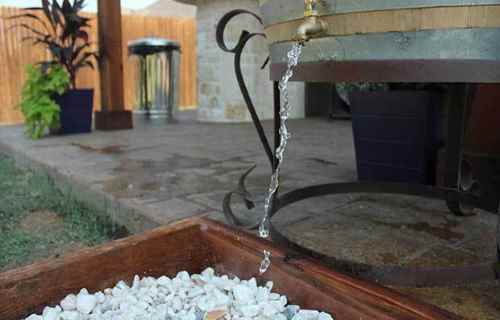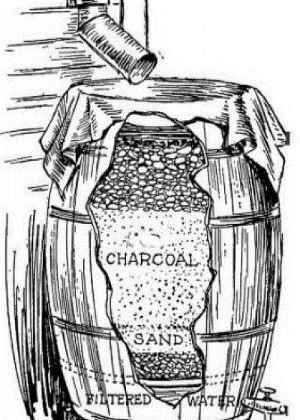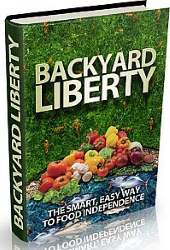100-Year-Old Way to Filter Rainwater in a Barrel
During our boiling, broiling, blistering summer of 2012 here in the Missouri Ozarks, water was a topic of conversation wherever we went. Creeks and ponds dried up (some never recovered) and the water table dropped, forcing a few neighbors to have their well pumps lowered or to even have deeper wells drilled.
Many folks shared memories of rain barrels, cisterns, hand pumps and drawing water with a well bucket as a child, usually on grandpa and grandma’s farm. Some said they’d never want to rely again on those old-time methods of getting water. But, at least they knew how it was done.
It seems we have lost much practical knowledge in the last 50 or so years because we thought we’d never need it again. Now we are scrambling to relearn those simple know-hows.
A tattered, 4-inch thick, 1909 book I happily secured for $8 in a thrift store reveals, among umpteen-thousand other every-day skills, how to make homemade water filters. The instructions in “Household Discoveries and Mrs. Curtis’s Cookbook” are quite basic as everyone had a rain barrel back then and presumably knew how to filter rainwater. Now, 104 years later, I am thankful the authors had the foresight to preserve their knowledge for us, and pointed out that rainwater collected in barrels from a roof is a necessity in some locations, but also is best for laundry and “often more wholesome for drinking purposes than hard water.”
The “wholesome” observation applies to plants, too. I noticed during our 6-week dry spell (not a drop of rain) that I was only able to keep my vegetables alive with the garden hose – until our well, too, began sucking air. The pitiful potato, tomato and bean plants actually seemed petrified, like faded plastic decorations. Then, after a 2-hour rain shower, the plants miraculously leapt to life – vibrant, green and THRIVING. I did, too.
In early June last year, my husband surprised me with a 425-gallon water tank so I could water with nutritious rainwater, although it was August before any measure of water was in the tank. When the elusive rains finally paused briefly overhead, I was out in it with my 2-gallon watering can, running and sloshing the water like a crazy woman onto our neglected trees far up the hill.
100-year-old instructions
For gardening, rainwater is, naturally, best unfiltered. But, for household use, the vintage book says the following instructions yield a cheap and easy way to make a filter just as good as a patent filter costing 10 times as much:
“Take a new vinegar barrel or an oak tub that has never been used, either a full cask or half size. Stand it on end raised on brick or stone from the ground. Insert a faucet near the bottom. Make a tight false bottom 3 or 4 inches from the bottom of the cask. Perforate this with small gimlet holes, and cover it with a piece of clean white canvas.
“Place on this false bottom a layer of clean pebbles 3 or 4 inches in thickness; next, a layer of clean washed sand and gravel; then coarsely granulated charcoal about the size of small peas. Charcoal made from hard maple is the best.
“After putting in a half bushel or so, pound it down firmly. Then put in more until the tub is filled within 1 foot of the top. Add a 3-inch layer of pebbles; and throw over the top a piece of canvas as a strainer. This canvas strainer can be removed and washed occasionally and the cask can be dumped out, pebbles cleansed and charcoal renewed every spring and fall, or once a year may be sufficient.
“This filter may be set in the cellar and used only for drinking water. Or it may be used in time of drought for filtering stagnant water, which would otherwise be unpalatable, for the use of stock. This also makes a good cider filter for the purpose of making vinegar. The cider should first be passed through cheese cloth to remove all coarser particles.
“Or a small cheap filter may be made from a flower pot. A fine sponge may be inserted in the hole and the pot filled about as directed for the above filter. It may be placed in the top of a jar, which will receive the filtered water.”(source)
RELATED : The Best 5 Gardening System to Grow Food for all Your Family Every Year Even in a Desert
Linda Holliday lives in the Missouri Ozarks where she and her husband formed Well WaterBoy Products, a company devoted to helping people live more self-sufficiently off grid, and invented the WaterBuck Pump. A former newspaper editor and reporter, Holliday blogs for Mother Earth News, sharing her skills in modern homesteading, organic gardening and human-powered devices.
The Lost Ways (Learn the long forgotten secrets that helped our forefathers survive famines,wars,economic crisis and anything else life threw at them)
Survival MD (Best Post Collapse First Aid Survival Guide Ever)
Backyard Innovator (A Self Sustaining Source Of Fresh Meat,Vegetables And Clean Drinking Water)
Blackout USA (EMP survival and preparedness)
Conquering the coming collapse (Financial advice and preparedness )
Liberty Generator (Build and make your own energy source)
Backyard Liberty (Easy and cheap DIY Aquaponic system to grow your organic and living food bank)
Bullet Proof Home (A Prepper’s Guide in Safeguarding a Home )
Family Self Defense (Best Self Defense Strategies For You And Your Family)
Survive Any Crisis (Best Items To Hoard For A Long Term Crisis)
Survive The End Days (Biggest Cover Up Of Our President)
Drought USA (Discover The Amazing Device That Turns Air Into Water)





Would that water be safe to drink?
Belay that, I didn’t read the entire article.